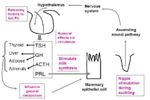Lactation - Endocrine Control - Anatomy & Physiology
Mammogenesis
- Initial duct growth is stimulated by oestrogen, growth hormone and glucocorticoids.
- Prolactin and progesterone are important for lobular alveolar growth.
Lactogenesis and Galactopoesis
- Regulated by a lactogenic complex consisting of mainly prolactin and growth hormone, but also thyroid hormones, corticosteroids and insulin.
- Prolactin acts on mammary secretory epithelial cells to stimulate synthesis of milk proteins. It is released during suckling and in response to the rise in oestrogen and glucocorticoids in parturition.
- Depends on interaction of genetic potential and nutritional status.
- Build up to peak yield, then a decline as the offspring requirement diminishes.
- Depends on the frequency of suckling stimulus to cause release of the lactogenic complex.
Milk Ejection Reflex
- Oxytocin is synthesised by magnocellar neurones of the Paraventricular nucleus (PVN) and Supraoptic nucleus (SON) of the Hypothalamus .
- Oxytocin is secreted from the Posterior Pituitary Gland.
- Plasma oxytocin concentration rises rapidly following suckling stimulation via a neuroendocrine reflex and exibit positive feedback. The positive feedback loop is terminated when stimulation of the teat ceases.
Afferent pathway
Mechanical stimulation of the teats activates pressure sensitive receptors in the dermis where the pressure is transformed into nerve impulses that travel via the spinothalamic nerve tract to the brain. These nerves synapse in the PVN and SON. When the cell bodies of the oxytocin-containing neurons are stimulated by these impulses originating in the teat, an action potential moves down the oxytocin-containing neurons from the cell body in the hypothalamus down the axon to the neuron ending in the posterior pituitary. This causes release of oxytocin and neurophysin into the blood.
Efferent Pathway
The efferent pathway begins with the release of oxytocin into the blood. The oxytocin travels to the mammary gland via the blood. It binds to oxytocin receptors on the myoepithelial cells, causing the myoepithelial cells to contract. This results in increased intra-lumenal pressure and ejection of milk from the alveolar lumen. Oxytocin receptors are associated with the myoepithelial cells, not the smooth muscle of the mammary gland.
- The neuroendocrine reflex may become a conditioned behavioural reflex, such that a cow going to the milking parlour will have elevated levels of oxytocin in the plasma prior to stimulus being applied to the teats.
- Oxytocin exibits a local positive feedback effect in the hypothalamus to trigger maternal behaviour and the maternal bonding process. Hence stimulating the cervix of a foster ewe to trigger the Fergessons reflex and thus trigger oxytocin release makes accepting the orphaned lamb more likely.
